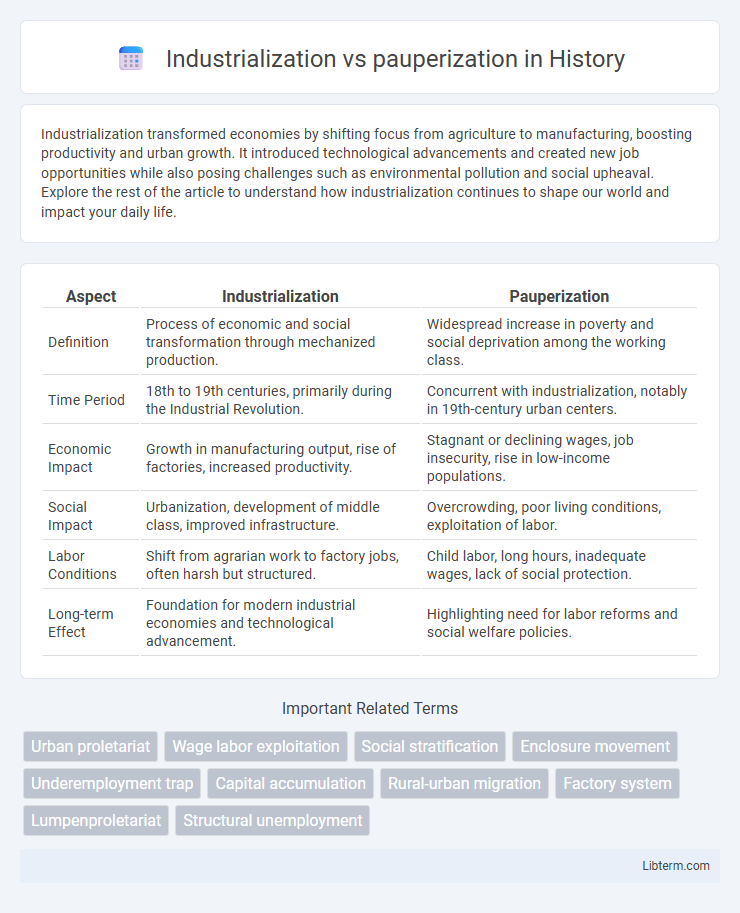Industrialization transformed economies by shifting focus from agriculture to manufacturing, boosting productivity and urban growth. It introduced technological advancements and created new job opportunities while also posing challenges such as environmental pollution and social upheaval. Explore the rest of the article to understand how industrialization continues to shape our world and impact your daily life.
Table of Comparison
| Aspect | Industrialization | Pauperization |
|---|---|---|
| Definition | Process of economic and social transformation through mechanized production. | Widespread increase in poverty and social deprivation among the working class. |
| Time Period | 18th to 19th centuries, primarily during the Industrial Revolution. | Concurrent with industrialization, notably in 19th-century urban centers. |
| Economic Impact | Growth in manufacturing output, rise of factories, increased productivity. | Stagnant or declining wages, job insecurity, rise in low-income populations. |
| Social Impact | Urbanization, development of middle class, improved infrastructure. | Overcrowding, poor living conditions, exploitation of labor. |
| Labor Conditions | Shift from agrarian work to factory jobs, often harsh but structured. | Child labor, long hours, inadequate wages, lack of social protection. |
| Long-term Effect | Foundation for modern industrial economies and technological advancement. | Highlighting need for labor reforms and social welfare policies. |
Understanding Industrialization: Definitions and Key Features
Industrialization refers to the large-scale transformation of economies from agrarian-based to manufacturing and industrial production, characterized by mechanization, increased factory work, and technological innovation. Key features include the rise of urban centers, mass production, and a shift towards wage labor, which significantly alters social structures and economic activities. While industrialization drives economic growth and development, it can also lead to pauperization, where low wages and poor working conditions contribute to poverty among the working class.
Pauperization Explained: Causes and Consequences
Pauperization refers to the process by which individuals or groups experience a significant decline in economic status, leading to increased poverty and deprivation. Key causes include rapid industrialization that displaces traditional labor, unequal wealth distribution, and exploitation of workers through low wages and poor working conditions. Consequences of pauperization encompass social instability, reduced access to education and healthcare, and entrenched cycles of poverty that hinder economic development.
Historical Context: Industrialization and Social Change
Industrialization in the 18th and 19th centuries drastically transformed economies by shifting production from agrarian-based systems to mechanized factories, leading to unprecedented urban growth and labor specialization. This rapid industrial growth fostered wealth accumulation for entrepreneurs but also resulted in pauperization, as many workers faced low wages, poor living conditions, and job insecurity amidst overcrowded cities. Historical social changes include the rise of the working class, labor unions, and early social reform movements aimed at addressing the socioeconomic disparities caused by industrial capitalism.
Economic Growth vs. Widening Inequality
Industrialization drives significant economic growth by increasing productivity, innovation, and job creation, yet it often leads to widening income inequality as wealth concentrates among capital owners and skilled workers. The rapid expansion of industries can marginalize unskilled labor, causing pauperization in vulnerable communities despite overall national prosperity. Policies addressing wage disparities, access to education, and social safety nets are critical to balancing economic growth with inclusive development.
The Role of Labor in Industrialized Societies
Labor in industrialized societies often experiences a paradox where increased production does not translate to improved living standards, leading to pauperization despite economic growth. Industrialization restructures labor markets, emphasizing mechanization and division of labor, which can reduce workers' bargaining power and income stability. This dynamic highlights the need for labor rights and social safety nets to mitigate the socioeconomic disparities generated by rapid industrial growth.
Urbanization: Catalyst for Progress or Poverty?
Urbanization during industrialization significantly accelerated economic growth by concentrating labor and resources in cities, fostering innovation and productivity. However, rapid urban influx often outpaced infrastructure development, leading to overcrowded slums, inadequate sanitation, and widespread poverty among industrial workers. The duality of urbanization as both a catalyst for progress and a driver of pauperization highlights the critical need for balanced urban planning and social policies to mitigate inequality.
Industrial Policies and Their Impact on Poverty Rates
Industrial policies promoting large-scale manufacturing growth often accelerate economic development by creating jobs and increasing incomes, yet they can also contribute to pauperization if benefits are unevenly distributed. Targeted industrial strategies that include investment in skill development, small-scale industries, and rural infrastructure tend to reduce poverty rates by enabling broader participation in economic gains. Conversely, neglecting inclusive policies may exacerbate social inequalities, leading to persistent or worsening poverty despite industrialization.
Technological Advancements: Opportunity or Threat to Low-Income Groups?
Technological advancements during industrialization often create productivity gains but can disproportionately threaten low-income groups by displacing unskilled labor and exacerbating income inequality. Automation and mechanization reduce demand for manual workers while increasing returns to capital and skilled labor, leading to pauperization in vulnerable communities. Targeted policies and inclusive innovation are essential to transform technological progress into opportunities rather than threats for low-income populations.
Global Perspectives: Comparing Industrialization and Pauperization Worldwide
Industrialization has driven economic growth and urbanization across countries like China, India, and Brazil, fostering technological innovation and expanding job markets, while some regions in Sub-Saharan Africa and parts of Latin America face pauperization due to unequal wealth distribution and limited industrial development. Global disparities in infrastructure, education, and governance contribute to divergent outcomes where industrialized nations experience rising incomes yet also environmental challenges, whereas pauperized areas struggle with persistent poverty and limited access to basic services. Comparative studies reveal that targeted investment in sustainable industrial policies and social safety nets can mitigate pauperization and promote inclusive economic progress worldwide.
Towards Inclusive Development: Solutions to Mitigate Pauperization
Industrialization can drive economic growth but often results in pauperization by displacing low-skilled workers and exacerbating income inequality. Promoting inclusive development requires policies such as investing in education and vocational training to enhance workforce skills, implementing social safety nets, and encouraging equitable access to technology and capital. These strategies aim to create sustainable employment opportunities and reduce poverty while maintaining industrial progress.
Industrialization Infographic

 libterm.com
libterm.com